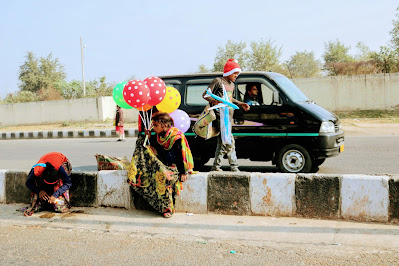India, with its rich cultural heritage, diverse landscapes, and growing economy, often fascinates people from around the world. However, when it comes to considering India as a place to live, there are several significant challenges that cannot be overlooked.
This blog explores the various reasons why India might not be the best place to settle down, despite its many attractions!
10 reasons why India is not the best place to live
1. Poor standard of living
The standard of living in India is generally lower compared to many developed countries. Issues like inadequate healthcare, poor infrastructure, and limited access to clean water and sanitation facilities affect a large portion of the population.
The disparity between urban and rural areas further exacerbates these problems, making it difficult for many to achieve a comfortable living standard.
2. High taxation
India has a relatively high taxation system, which can be burdensome for residents. The Goods and Services Tax (GST), along with other direct and indirect taxes, can significantly reduce disposable income.
For businesses, the complex tax structure and frequent changes in tax laws add to the financial strain, making it challenging to operate smoothly.
3. Low income levels
Despite being one of the fastest-growing economies, income levels in India remain low for a vast majority of the population. The minimum wage is insufficient to meet basic needs, and even professionals often find their salaries falling short compared to global standards.
This low income level impacts the overall quality of life, limiting access to better housing, education, and healthcare.
4. Widespread poverty
India still struggles with significant levels of poverty. According to various reports, a considerable percentage of the population lives below the poverty line.
This widespread poverty leads to malnutrition, poor living conditions, and limited opportunities for economic advancement, creating a challenging environment for residents.

5. Expensive real estate
Property rates in India, especially in major cities like Mumbai, Delhi, and Bangalore, are exorbitantly high. The cost of purchasing or renting a home in these urban centers can be prohibitively expensive, making it difficult for many to afford decent housing.
This high cost of real estate adds to the financial pressures on residents.
6. Pollution
India ranks among the countries with the highest pollution levels in the world. Major cities like Delhi frequently experience hazardous air quality, which poses severe health risks.
Additionally, water pollution and improper waste management contribute to environmental degradation, affecting the overall well-being of the population.

7. Extreme weather conditions
The weather in India can be extreme and unpredictable. Summers are often unbearably hot, with temperatures soaring above 40 degrees Celsius in many regions.
Monsoons bring heavy rainfall, leading to floods and disruption of daily life. Winters in the northern parts can be harsh and cold, creating further discomfort.
8. High crime rate
India has a relatively high crime rate, with frequent reports of theft, assault, and other criminal activities. Certain cities are particularly notorious for their crime levels, making safety a major concern.
Living in India as a woman can be especially challenging due to the high incidence of gender-based violence and harassment.
9. Inadequate healthcare system
While India has made strides in healthcare, the system is still plagued by issues such as overcrowded hospitals, shortage of medical staff, and lack of advanced medical facilities in rural areas.
The high cost of private healthcare is another deterrent, making quality healthcare inaccessible for many.
10. Bureaucratic hurdles
India’s bureaucratic system can be cumbersome and slow, often leading to delays and inefficiencies. Whether it’s obtaining permits, registering property, or dealing with other government-related processes, the bureaucratic red tape can be frustrating and time-consuming.
Benefits of living in India
- Rich cultural heritage: India’s cultural diversity is unparalleled, offering a unique blend of traditions, languages, festivals, and cuisines. For those who appreciate history and culture, living in India can be an enriching experience.
- Growing economy: Despite the challenges, India’s economy is growing rapidly, offering numerous opportunities for business and investment. For entrepreneurs and professionals, this growth presents potential for economic gains and career advancement.
- Affordable cost of living: While real estate in major cities is expensive, the overall cost of living in many parts of India can be quite affordable. Daily expenses, such as food and transportation, are relatively low, making it possible to live comfortably on a modest income.
- Warm hospitality: Indians are known for their hospitality and friendliness. Living in India as a foreigner can be a welcoming experience, with locals often going out of their way to help and make you feel at home.
- Scenic landscapes: India boasts a diverse range of landscapes, from the Himalayas in the north to the beaches of Goa in the south, and from the Thar Desert in the west to the lush tea plantations in the east. For nature lovers and adventure enthusiasts, India offers endless exploration opportunities!
- Spiritual and wellness retreats: India is renowned for its spiritual heritage and wellness practices. Places like Rishikesh, Varanasi, and Kerala offer numerous retreats and programs focusing on yoga, meditation, and holistic healing, attracting those seeking spiritual growth and well-being.
- Educational opportunities: India is home to several prestigious educational institutions. While there are challenges, the country offers a range of study programs in diverse fields. For students asking, “Is India a good country to study?” the answer can be positive, particularly for those interested in fields like engineering, medicine, and the humanities.
- Expanding IT and tech industry: India is a global hub for the IT and technology industry, providing numerous job opportunities in this sector. Cities like Bangalore, Hyderabad, and Pune are known for their thriving tech ecosystems.
- Vibrant urban life: Cities like Mumbai and Delhi offer a vibrant urban lifestyle with a plethora of dining, shopping, and entertainment options. The bustling city life can be appealing for those who enjoy a fast-paced environment.
- Community and family bonds: Indian society places a strong emphasis on community and family bonds. This sense of close-knit relationships and support systems can be comforting and enriching for many.
While India has its share of significant challenges that make it less than ideal for many to consider living here, it also offers a rich tapestry of cultural experiences, economic opportunities, and natural beauty.
Weighing the pros and cons of living in India is essential for anyone considering making it their home. Understanding the disadvantages of living in India, from poor living standards to high crime rates, can help in making an informed decision.
At the same time, appreciating the unique benefits, such as cultural richness and economic potential, provides a balanced perspective on what living in India entails!
Also, if you are planning to move abroad, learn why the USA has become a top destination for Indians.

